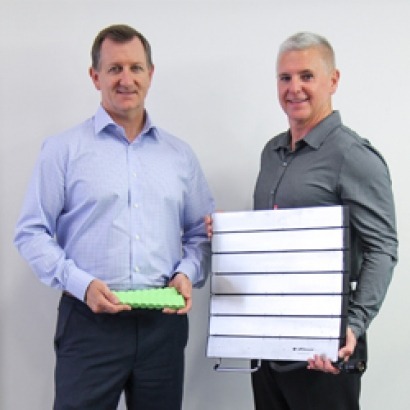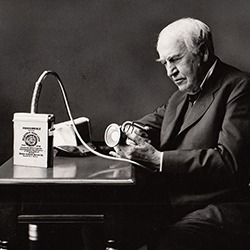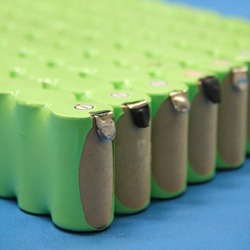
ZincFive, Inc. has created the world's first nickel-zinc smart battery, a reliable and environmentally friendly alternative to many of the safety concerns associated with lead acid and lithium ion batteries. Nickel-zinc will be only the fifth battery chemistry in history to globally scale. It was originally invented by Thomas Edison and was his dream battery chemistry, but he wasn't able to commercialise it. ZincFive has now done just that.
Intelligent transportation, traffic, data centers, automotive and telecom need safe battery backup to keep systems operating, even when the utility power dies. Nickel-zinc is being used right now in intelligent transportation systems across North America, replacing lead-acid batteries. The company is also close to developing the technology for applications in other mission critical industries.
REM talked to Tim Hysell, President and CEO of ZincFive and Todd Higinbotham, former CEO of PowerGenix
Tell me about ZincFive and what it does
Tim: We’re an advanced UPS manufacturer, so an Uninterruptible Power Supply company, but what makes us quite unique is several things. First and foremost we utilise a battery chemistry called nickel zinc and what makes us special is that we’re also the owner of nickel zinc in terms of manufacturing. We own 62 issued patents around nickel zinc and so we’re quite excited that we’ve taken this and integrated and verticalised if you will, into a single company with the acquisition and merger of PowerGenix. So we own the battery chemistry as well as the integrated solutions, but we also create the battery chemistry, which is our first UPS called the UPStealth, which we have commercialised already into the mission critical signalised intersection across the US and Canada.
Tell me about this nickel-zinc smart battery, and what advantages it offers over lead-acid and lithium-ion batteries
Todd: Nickel zinc is a chemistry that’s been around for a very long time. It was originally invented by Thomas Edison and people have been working on the chemistry for many, many years, trying to overcome one of its ‘Achilles Heels’ which is that the battery doesn’t cycle very long. It provides a very, very high power density, much like a lithium ion battery, but unfortunately the chemistry had side effects in that it wasn’t able to cycle. So in the mid-90’s to 2000’s, a company called PowerGenix, which recently merged with ZincFive, had a breakthrough in the chemistry and got it to cycle very, very well.
As Tim mentioned we have over 100 patents filed with over 60 issued, all around building a cycleable, scalable, nickel zinc system. Basically what you have is a battery with really high power density, very high cycleability, and where it sits in the scheme of things is that basically it sits between lithium ion and lead acid. In most respects it operates like a lead acid battery, a very safe, non-flammable, but it has much higher cycleability and much higher energy density. In fact, it is about five times the density of a lead acid battery, more like a lithium ion. The beauty of it is that it’s extremely safe and very environmentally friendly, so its not flammable, it can’t explode. The materials used, we don’t use anything like sulphuric acid or lead, just a harmless electrolyte, and so the mission critical applications, like Tim said, are, first, in the traffic system in the United States, people are looking for something just like this – very safe, environmentally friendly and its reliable.
The earliest applications adopting these, they’ve been traditionally served by lead acid batteries, but they need higher performance and reliability, and that’s where we are starting to get adopted. So basically, UPS systems in traffic, UPS systems in data centres, and applications like that.
So that more or less answered my next question, which was what potential applications does it have?
Tim: Well we can expand on that. Our next product in terms of the UPS is for data centres, but it doesn’t stop there. There’s a high demand for this kind of battery chemistry, not necessarily the UPS but the battery chemistry, in a multitude of applications that PowerGenix and Todd have spearheaded for a number of years now. The use of nickel zinc in the automotive stop-start application – nickel zinc yields a very nice solution there, there are other conversations going on right now about other opportunities that right now are a bit confidential, but those are things that will change some of the markets that have traditionally been served by lead acid. They will change significantly as they adopt nickel zinc. So we’re really excited about our solutions relative to UPS’s, but also about our battery chemistry which lends itself to many, many opportunities.

What stage are you at with regard to development and commercialisation?
Tim: The battery chemistry is already available in multiple sizes, commercially available, and the UPS for the traffic application, we use a battery called the SubC. On the automotive stop-start application as well as other markets we’re addressing right now, we’ll be using a larger battery called the Monoblock battery, which is more the size of a traditional lead acid car battery but has five times greater energy density. Those batteries are already commercially available, we’re shipping those now. We’ve been shipping the UPStealth as a UPS for signalised intersections for a number of years.
Is this new technology already being used, and if so where?
Todd: For nickel zinc itself, the answer is no, due to the history I mentioned. Many companies tried to work on nickel zinc but they just couldn’t work out some of the chemistry challenges. So PowerGenix and now ZincFive, we are now the pioneers of nickel zinc as far as commercialisation. The UPS application in traffic is the first commercial market. We have about 800 systems installed in the US and Canada and its starting to scale very quickly.
A few years ago we signed a licence agreement with a company called Enersys, which is a large US company and one of the leaders in batteries in the world. A few months ago, in June, Enersys announced they had started sampling nickel zinc batteries to their customers and that it was going quite well so that their intention was to bring it up to full commercial scale through 2017. That announcement was the culmination of about three years of work between PowerGenix and Enersys. We were the technology partner and Enersys was commercialising the technology.
What are your key target markets for this technology?
Tim: We want to expand quite rapidly into the signalised intersection space. But there are several other spin-offs of that market, such as railroad crossings, which are very hazardous environments without utility power feeding those locations. We are also taking the battery technology, in the next 60 days or so, to emergency vehicles. We are partnering with another company that will be using nickel zinc for emergency vehicles, so an ambulance can arrive at a scene, shut its engines off but keep the air conditioning and the safety equipment that’s inside to treat the patient – all of those things stay online and ready to be used but they’re operating off the battery.
Todd: Almost every application we’re going after falls under the terminology of ‘anti-idle’. In Europe, they’re really leading the charge in automotive stop-start in micro hybrids and there’s already about 20 million vehicles per year now sold. So when a vehicle comes to a stop, now there’s no reason to burn fuel. You can switch to a battery system and keep all the equipment running, such as air conditioning and lights and entertainment. This is a trend because the technology now being deployed is continuing to improve, especially with regard to CO2 efficiency of vehicles. What Tim was talking about, the emergency vehicles, they have the same issue but ambulances, police cars, military vehicles do a lot of stop-starting per day, anything from 2 minutes to an hour. Today, most of those vehicles keep their engines idling, burning fuel, because their systems need to be available and they need to keep their equipment warm. Anti-idling in truck applications, US long-haul truckers have sleeper cabs in which they sleep and rest 10 hours per day, but most of them still run their diesel engine to keep the air conditioning going. Nickel zinc looks like a phenomenal replacement for lead acid because you can cycle it many, many times and it won’t die prematurely while also offering safety.
Lithium ion is a very good alternative, but there are concerns around safety, especially in a micro-hybrid, which is not an electric vehicle (EV), it has a fuel tank. Having a flammable battery next to that is something that high volume automotive manufacturers are very concerned with. In EVs, lithium is the absolute clear winner, whether it’s a Tesla or a Chevy Volt. Nickel zinc is not competing in that space. It’s the absolute champion of fast-charging though, 15 minutes or 10 minutes for a very large battery, and it doesn’t get hot. You don’t need HVAC to cool the batteries, which is a huge saving in energy and cost.

Are you mainly looking at North America for these batteries or elsewhere as well?
Todd: As far as PowerGenix are concerned, we were really focusing on Europe, because Europe is one of the leaders in stop-start technology. Peugeot in France was the first company to approach us about this type of battery and we have been going through qualification with Peugeot, Porsche and several other European companies for several years. Our UPS though is focused on the US first.
Tim: Yes, we’re focused on the US and Canada with the current product line in the traffic space and railroad crossings but we do have intentions to make modifications to the product to make it a global product. Something else that is really important is that the reason we chose to merge these two companies is because we knew what the battery chemistry was capable of, as we had commercialised it into a UPS but we’re bringing to the world is not just the battery chemistry but the intelligence that you wrap around the battery chemistry to make it fit into multiple applications and markets. ZincFive is the world holder in the intelligence around battery management software relative to nickel zinc. This is really important because as the companies come to us, they’re unfamiliar with nickel zinc, so it’s incumbent on us in certain applications to be able to say, ‘this is how you maximise this battery chemistry for your world, with our intelligence’. That can be either software or a number of things. We’re not just a battery company, we’re a full solutions provider of nickel zinc and we’re the only one on the planet.
Are you working with any partners on this project?
Tim: An example of that would be the emergency vehicles with regard to sales and distribution, the power block created to accept the battery, Enersys is very much of a strategic partner, in the traffic sector we’ve recently brought on two very substantial distribution companies, Econolite and MoboTrex.
Todd: We’re going to pioneer the applications in all these spaces but when it comes to traffic, the traffic intersection has a multitude of different technologies and products that go into that. Companies like Econolite and MoboTrex have dominated that space in the US so we’re working with them to bring the product to the end users, such as municipalities in the US states and local governments. We’re also working with a major partner in Japan, the name of the company is confidential, but we’re the enabler and so we’re looking out for strategic partners and are well on our way with that process.
Tim: I don’t know if you’re seeing much conversation around smart cities in the UK but we’re really excited about where the UPStealth fits in to the whole smart cities plan, so when you look at vehicle to vehicle communication with autonomous driving, you look at vehicle to infrastructure communication, so in other words vehicles communicating directly with the infrastructure systems that will be in place in these smart cities, it is absolutely imperative that utility power is always maintained because the loss of that will compromise safety significantly. You’ll find that the back office hubs will be those signalised intersections that will be communicating with those vehicles and also the infrastructure of the city, and so we’re really excited about the UPStealth already being deployed in that space, already having remote communication which is very sophisticated.
What does the future look in five to ten years’ time?
We’re really excited because we just fit this huge void where people are looking for better performance above and beyond lead acid and looking for high performance like lithium ion but safer. If you look at the battery world right now there is an enormous opportunity for something like that, and we have the answer and that is nickel zinc.
Image: Former PowerGenix CEO Tod Higinbotham with ZincFive President & CEO Tim Hysell
For additional information:

